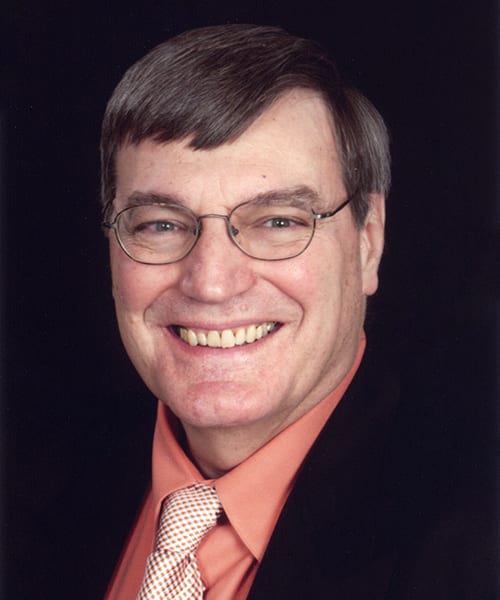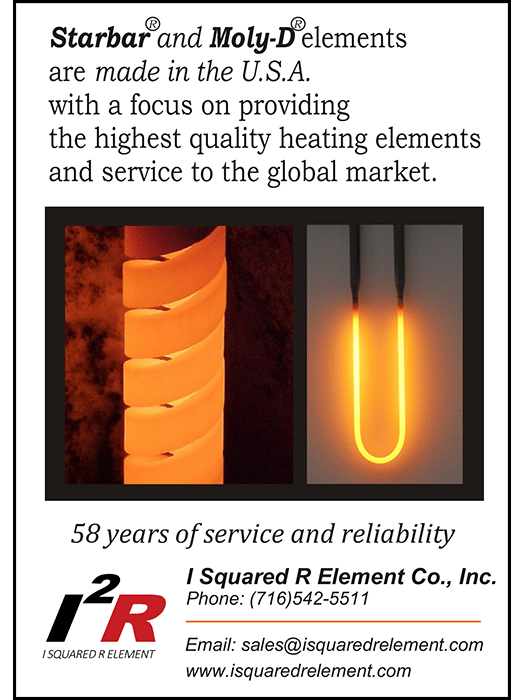bulletin | feature story
Honoring the ACerS Awards Class of 2023
Over its long history, The American Ceramic Society has established a tradition of awards to recognize its members’ outstanding contributions and accomplishments and to create career benchmarks for aspiring young scientists, engineers, and business leaders. The most prestigious of ACerS awards is Distinguished Life Member designation, a recognition bestowed upon only two or three members each year. In 2023, two individuals will receive DLM honors: Edwin R. Fuller and Curtis A. Johnson.
The Society will elevate 20 members to Fellow and recognize many more outstanding members with various Society, Division, and Class awards during the ACerS Annual Honor and Awards Banquet Reception on Oct. 2, 2023.
2023 Distinguished Life Members
Edwin R. Fuller
Sometimes it takes looking back to realize your dream career was staring you in the face all along, even if you did not realize it at the time.
“I went to graduate school at the University of Illinois Urbana-Champaign, and I used to study a lot over in the ceramics library, which was across the street from the building where I was, the Physics Building. And so I would go over there to study because the library was so quiet. But I didn’t think anything at all about ceramics. I would have never dreamt at that time that I would have ended up in ceramics; that it would be my home society,” says Edwin “Ed” Fuller.
Fuller’s path to materials research—and ceramics specifically—began after graduate school, when he joined the National Bureau of Standards, now the National Institute of Standards and Technology (NIST), as a National Research Council Postdoctoral Fellow. He initially planned to conduct research on traditional physics topics, in line with his education. But he became fascinated with the field of fracture mechanics after sharing an office with ACerS DLM Anthony “Tony” Evans.
Just into his second year as a postdoc, Fuller attended ACerS Annual Meeting to present his work with Evans on the fracture mechanics of ceramic and glass materials. That year, John B. Wachtman, Jr. gave the Sosman Award Lecture on the topic of fracture mechanics, which solidified Fuller’s interest in the field.
With the advances of computers in the 1980s, Fuller became immersed in developing computer simulations to model micromechanical behavior of heterogeneous, stochastic microstructures. His seminal contributions to this field include leading development of the computer software program Object-Oriented Finite Elements, or OOF, which was one of the earliest computational tools developed to predict material behavior by inputting either experimental and/or fundamental data.
Fuller’s research on simulations has been widely recognized. He is a recipient of the ACerS Ross Coffin Purdy Award (1987), the NIST Jacob Rabinow Applied Research Award (2000), and the Basic Science Division Robert B. Sosman Award (2004).
In 1999, he along with along with S. A. Langer, W. C. Carter, and A. R. Roosen were awarded one of Industry Week’s Technology of the Year awards for developing OOF.
In addition to his involvement with ACerS Basic Science Division, Fuller gained many friends in the Refractory and Cements Divisions when he conducted research in those areas during the 1970s energy crisis. In the 2010s, he became involved in the Art, Archaeology & Conservation Science Division as a result of previously inviting a Smithsonian researcher to join his processing group and use some of their equipment.
Besides his expansive engagement across multiple ACerS Divisions, Fuller also was involved in the Baltimore–Washington Section (now the Washington DC/Maryland/Northern Virginia Section), where he served in all leadership positions. Today he is active in the recently formed Carolinas Section. He also served ACerS as chair of various committees, on the Board of Directors (2007–2011), and as ACerS president (2009–2010).
Fuller says he is honored to be recognized as a DLM in a society that, over the course of his career, became a “natural home” full of supportive mentors who aided his growth as a young professional. He specifically wants to acknowledge the mentorship of Shelly Wiederhorn, also a DLM, who became a mentor, then a colleague, and then a friend.
“I wouldn’t be where I am today without the mentors that I’ve had,” he says.


Curtis A. Johnson
A small town about 10 miles outside of Johnstown, Pa., with a population of roughly 600 people may have the largest number of ceramic engineers per-capita in the United States. Certainly, the town can boast the largest number of ACerS Distinguished Life Members per capita with the elevation of Curtis A. Johnson, whose brother David is also a DLM. Johnson and his brother have the added distinction of being the Society’s first sibling DLMs.
Johnson points to several factors that led him to his career in ceramic engineering.
“My father worked for Bethlehem Steel. It was a metals town. There were always metals and metallurgy around,” he says. Additionally, “We grew up in a household that always challenged us to understand why things work.”
Johnson found himself drawn to applied sciences more than the pure sciences, leading him to study metallurgy at The Pennsylvania State University, where he earned B.S. and Ph.D. degrees. His five-years-older brother David had studied ceramic science at Penn State, so metallurgy seemed like a good way to avoid “following his brother.”
Fate had other plans. Just down the hall from the metallurgy program, Johnson got to know the students and professors working on ceramic engineering research projects. He came to the (natural) conclusion that “ceramics were more interesting than metals.”
Johnson conducted his Ph.D. work under the guidance of DLM Richard Bradt on a project using metallurgical principles to understand creep in a ceramic material. He contemplated a career in academia, but he found himself drawn to a career in industrial research and its connection to products.
Upon completion of his Ph.D., Johnson joined General Electric’s Corporate Research and Development Center (now called General Electric Global Research), where he rose through the technical ranks to the role of principal scientist, the highest position afforded a bench scientist at GE.
“What really attracted me to GE were opportunities for diverse problems to get involved with,” he says.
Johnson is widely recognized for his contributions in the areas of mechanics of materials, thermal barrier coatings, and environmental barrier coatings, all of which have played a critical role in aerospace and land-based turbine engines. His understanding of mechanics coupled with his expertise in ceramics provided important insight into the failure of brittle materials. Today, all major jet engine aircraft manufacturers apply TBCs to their engine components, which allows engines to run at temperatures near 2,400°F.
“Ultimately, when these coatings fail or a CMC fails, there is a mechanical aspect to it. My involvement generally gets back to that core: What is the final threat that it’s going to fracture, delaminate, or spall?” he says.
His work on the development and deployment of a CMC shroud in GE’s LEAP engine was a fulfilling highlight of his career.
“Composites were thought of at the time of my Ph.D., but it seemed overwhelming to make something structural out of ceramics. It’s been very satisfying to see it go from something that people said would never happen to where we’ve had 25 million hours—not passenger hours—but aircraft hours,” he says.
Johnson joined the Society as a graduate student, and he has found ACerS meetings to be invaluable sources of interaction, networking, and exchange of ideas. Being named a DLM was unexpected.
“It’s overwhelming. I‘ve been involved in a lot of ceramic things that are important to me, the company, and maybe to society. I was really, really surprised when I got the call,” he says.
Of course, the most burning question is—do the Johnson brothers “talk shop” at Thanksgiving dinner? With a chuckle, Johnson admits, “We’re allowed to talk about it on the side, but the rest of the table doesn’t care!”


The 2023 Class of Fellows

CLICK HERE TO Learn more about THE fellows
2023 Society Awards
- Award: W. David Kingery Award
2023 Recipient: Vincent Harris, Northeastern University - Award: John Jeppson Award
2023 Recipient: Ruyan Guo, University of Texas, San Antonio - Award: Robert L. Coble Award for Young Scholars
2023 Recipient: Mattia Biesuz, University of Trento, Italy - Award: Ross Coffin Purdy Award
2023 Recipient: Paper title: “The structure of sodium silicate glass from neutron diffraction and modeling of oxygen–oxygen correlations," J. Am. Ceram. Soc.
– Alex C. Hannon, Rutherford Appleton Laboratory, U.K.
– Shuchi Vaishnav, Sheffield Hallam University, U.K.
– Oliver L. G. Alderman, Rutherford Appleton Laboratory, U.K.
– Paul A. Bingham, Sheffield Hallam University, U.K. - Award: Richard and Patricia Spriggs Phase Equilibria Award
2023 Recipient: Paper title: “Phase equilibria of MgO–Al2O3–TiO2 system at 1600°C in air: Emphasis on pseudobrookite and spinel," J. Am. Ceram. Soc.
– Yuchao Qiu, Northeastern University, China
– Song Li, Liupanshui Normal University, China
– Junjie Shi, Northeastern University, China
– Yumo Zhai, Northeastern University, China
– Bin Yu, Panzhihua Steel Group Research Institute Co. LTD, China
– Jianzhong Li, Northeastern University, China
– Changle Hou, Northeastern University, China
– Jingjing Dong, Northeastern University, China
– Changsheng Liu, Northeastern University, China
- Award: Morgan Medal and Global Distinguished Doctoral Dissertation Award
2023 Recipient: Mao-Hua Zhang, Technical University of Darmstadt, Germany - Award: Medal for Leadership in the Advancement of Ceramic Technology
2023 Recipient: Jacques Rennotte, Belgian Ceramic Research Centre - Award: Du-Co Ceramics Young Professionals Award
2023 Recipient: Lisa Rueschhoff, Air Force Research Laboratory - Award: Rishi Raj Medal for Innovation and Commercialization
2023 Recipient: Raj N. Singh, Oklahoma State University - Award: Navrotsky Award for Experimental Thermodynamics of Solids
2023 Recipient: Paper title: “Radiation damage and thermal annealing in tunnel structured hollandite materials,” Acta Mat.
– Kyle Brinkman, Clemson University - Award: Karl Schwartzwalder—Professional Achievement in Ceramic Engineering Award
2023 Recipient: Scott Cooper, Celsian - Award: ECerS-ACerS Joint Award
2023 Recipient: Francis Cambier, Belgian Ceramic Research Centre - Award: Corporate Environmental Achievement Award
2023 Recipient: RHI Magnesita - Award: Richard M. Fulrath Awards
2023 Recipients:
– American academic: Nicola Perry, University of Illinois at Urbana-Champaign
– American industrial: Amjad Almansour, NASA Glenn Research Center
– Japanese academic: Yukio Sato, Kyushu University
– Japanese industrials: Fuminori Mizuno, Toyota Motor Corporation; Sanshiro Aman, TDK Corporation
2023 Class and Division Awards
- Award: Education & Professional Development Council: Outstanding Educator Award
2023 Recipient: Brian P. Gorman, Colorado School of Mines - Award: Education & Professional Development Council: Greaves-Walker Lifetime Service Award
2023 Recipient: Kevin M. Fox, Savannah River National Laboratory (retired) - Award: Energy Materials and Systems Division: D.T. Rankin Award
2023 Recipient: Jake Amoroso, Savannah River National Laboratory - Award: Glass & Optical Materials Division: Cooper Distinguished Lecturer
2023 Recipient: Lothar Wondraczek, Otto Schott Institute of Materials and Research, Germany - Award: Glass & Optical Materials Division: Cooper Scholars
– 2023 Cooper Scholar Recipient: John Bussey, Washington State University
– 2023 Runner Up Recipient: Stuart Leland, Iowa State University
– 2023 Runner Up Recipient: Vaibhav Bihani, Indian Institute of Technology Delhi, India
– 2023 Runner Up Recipient: Yi Wei, Coe College
ACerS 2023 Award Lectures
- Award: Education & Professional Development Council: Arthur L. Friedberg Memorial Lecture
2023 Recipient: Kathy Lu, Virginia Tech; Lecture title: “Polymer derived ceramics—a new class of materials unrivaled by others” - Award: Edward Orton Jr. Memorial Lecture
2023 Recipient: Sergei Kalinin, Oak Ridge National Laboratory; Lecture title: “Microscopy is all you need: The rise of autonomous science” - Award: Frontiers of Science and Society – Rustum Roy Lecture
2023 Recipient: Mrityunjay Singh, Ohio Aerospace Institute; Lecture title: “Strategically aligned additive manufacturing: Disruptor to global supply chains and enabler of sustainable societal development” - Award: Basic Science Division: Sosman Lecture
2023 Recipient: Elizabeth Dickey, Carnegie Mellon University; Lecture title: “Defect disorder in electronic ceramics: Designing functionality”
